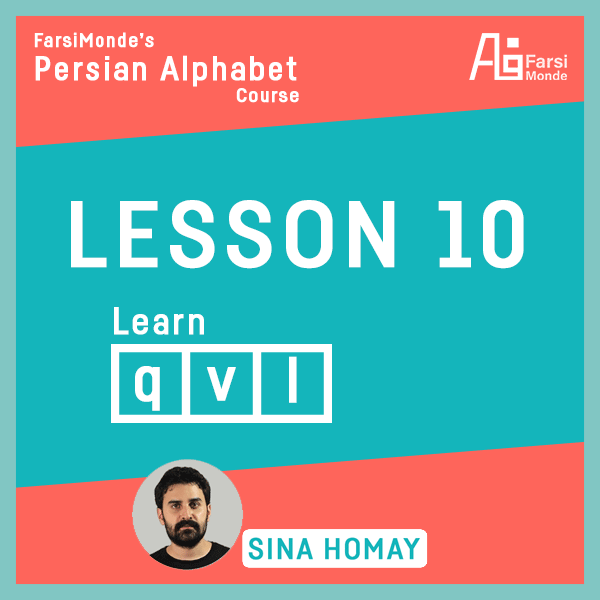Learning Persian Alphabet (10)

Welcome to the tenth episode of the Persian Learning Alphabet Series. In this lesson, you will learn how to write “q,” “l” and “v.” We have to admit that lesson ten of the Alphabet Series is the most difficult one in terms of pronunciation. Distinguishing between “l” and “r” or “v,” “b,” and “f” might be difficult for some Farsi learners; but pronouncing “q” correctly and distinguishing it from “g” or “k” is a burden for everyone. If you cannot master it in your first attempt, do not worry. You will manage it by practicing more.
Is it “l” or “r”?
In some languages, such as Japanese and Chinese “l” and “r” are pronounced similarly. The main difference between “l” and “r” in pronunciation is the shape of the tongue and the place of the palate that the tongue touches. To make the “l” sound the tip of the tongue raises and touches the back of the upper teeth but to make the “r” sound the middle of the tongue raises a little and gets close to the hard palate. The other difference is the shape of the lips. For producing “l” the lips remain neutral whereas for “r” the lips are a little round. If you need to practice “r” and “l” repeat the following words after Cinna.
dâr / dâl
bâr/ bâl
râm/ lâm
balâl / barâr
lâneh/ râneh
Now that you can pronounce these two sounds correctly, it is time to learn how to write “l.” It is very similar to the Latin capital “L.” You only need to turn it around to make it Persian.

L-in-Farsi
Is it “f,” “v,” or “b”?
These three sounds exist in many languages spoken all over the world. In Iranian standard Farsi, “f” and “v” are both labio-dental fricatives, and “b” is a bilabial. To pronounce “v” and “f” the lower lip touches the upper teeth, making a narrow channel for the air to flow. The only difference between these two sounds in Standard Iranian Persian is that the “f” is a voiceless fricative but “v” is voiced. In Dari and Arabic, “v” is mostly pronounced the same as the English “w,” so it is considered a labio-velar approximate rather than a labio-dental fricative.
The places of articulation of these three sounds in Iranian Farsi are very close, so it increases the possibility of mixing them up especially when “v” comes at the end of a word. You can repeat the following minimal pairs after Cinna to practice and figure out the differences among these sounds.
dâv/ dâf
gâv/ gâf
vâm/ bâm / fâm
vâli/ bâli
var/ far
Written form of “v” is very similar to “u.” The two sounds differ only when they come in the beginning. If you omit the vowel sign of “u” in the beginning of a word, you have the written “v.” The following examples help to understand better.
Ugândâ اوگاندا
Viyetnâm ویتنام
Is it “q” or “g”?
Welcome to the most troublesome consonant in Farsi, the “q” sound. The majority of Farsi learners cannot distinguish between the “q” and “g” sound at the beginning. Some may also mix the “q” “x,” and even “k” sounds. But here is a brief explanation to help you with the pronunciation of these sounds.
“g” and “k” are both plosive velar consonants. To produce plosive sounds the airflow is blocked by the tongue and a sudden release of air makes the sound. Moreover, to produce a velar sound back of the tongue raises to touch the back of the palate, called the soft palate. The only difference between “k” and “g” is that the former is a voiced consonant that vibrates the vocal cords, while the second one is voiceless. But what is the difference between these two sounds and “q”?
“q” is a uvular sound. This means that the back of the tongue goes up against the uvula; therefore. This means that uvular consonants are pronounced from the larynx and you can feel that something is coming out of your throat. The other uvular sound in Farsi is “x.” But “x” differs from “q” in the manner of articulation. The former is a fricative and the latter is a plosive. So the “q” sound is produced by stopping the airflow in the larynx, whereas the “x” sound is produced by narrowing down the air channel in the mouth.
The following table shows the differences between “q” and other sounds.
| g and q | x and q | k and q | |
|---|---|---|---|
| Similarities | Manner of articulation: both are plosives |
Place of articulation: both are uvular |
Manner of articulation: both are plosives |
| Differences | Place of articulation: “g” is velar while “q” is uvular |
Manner of articulation: “x” is a fricative while q is a plosive sound |
Place of articulation: “k” is velar while “q” is uvular |
Table 1. Comparison of q, g, k, & x sounds
Examples to practice
In this lesson, pronunciation is as important as learning the Persian alphabet, so we prepared two different exercises for this lesson to help you with both listening and writing skills.
-
Listen to the following words and write them in Farsi.
Listen to the following words and write them in Farsi.
Check the answers below the article
-
Write down the following sentences in Farsi.
Write down the following sentences in Farsi.
- Man va Taqi fardâ be Qom miravim. = Taqi and I will go to Qom tomorrow.
I and Taghi tomorrow to Qom go.PL
- Qâsem qârč va lubiyaa dust nadârad. = Qâsem does not like mushroom and bean
Qâsem mushroom & bean liking not-has
- Lâdan harruz varzeš mikonad. = Lâdan does sport every day.
Lâdan every day sport does
FarsiMonde’s tutors attempt to make learning the Persian Alphabet simple and enjoyable; therefore, we designed writing exercises you can work on at the end of each video. Click on below to start the new lesson’s quiz.
Quiz No. 10
Practice A answers:
- بار – باخ – بال
- لوس – روس
- قُم – گُم- رُم- خُم
- گاو- قاب – گاف


Leave A Comment